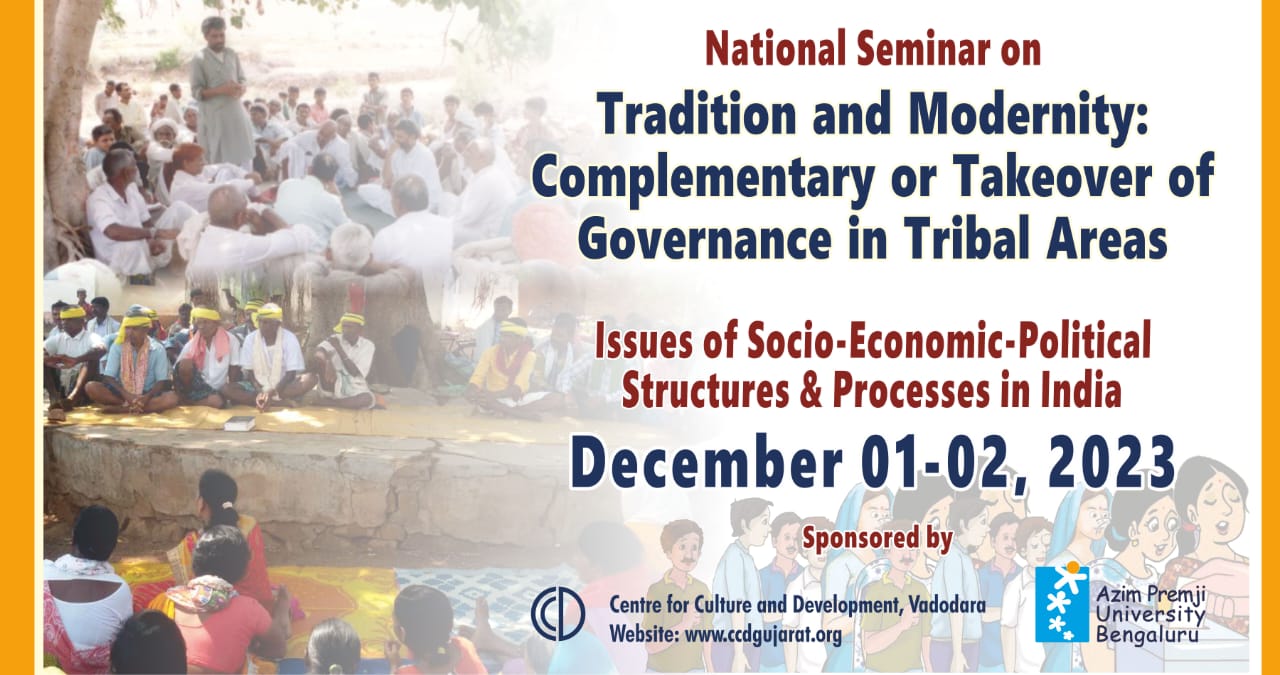
National Seminar
Tradition and Modernity: Complementary or Takeover of Governance in Tribal Areas, Issues of Socio-Economic and Political Structures and Processes in India
(December 01-02, 2023)
SUMMARY
By Kanchan Bharati
Political organizations are important components of the political life of a society in a democratic country. Distribution and composition of Indian population show that India is home to the largest numbers of tribes in the world. Tribal communities are known to have their own traditional social and political governing structures. They are mostly governed by self-rule through the collective way of customary methods and traditional systems of social control. The implementation of Panchayati Raj Institutions (PRIs) as a constitutional form of governance in the country in late 1990s brings out the fact that in tribal areas one can now see dual forms of governing structure; one – an informal traditional system of ‘Tribal Panch/Councils (TP)’ and the second a formal system of ‘Statuary Panchayats (GP)’. It is also important to note that despite constituting a distinct social category and special constitutional and legal provisions, Tribals are not outside the economic and political framework of India and Indian politics. As a part of the nation-building process, tribal areas have witnessed large-scale development in terms of industry, mining, infrastructure projects such as roads and railways, and hydraulic projects such as dams and irrigation. These have been followed by processes of urbanization as well. The overall impact of these has been that the Tribals, indigenous communities have entered a new phase of struggle and protests against these ‘development and urbanization’ processes. The variables across India have experienced substantial loss of livelihood, massive often coercive displacement, involuntary and distressed migration. The government of India on one hand has initiated several affirmative policies, schemes, enacted laws for the welfare, development and protection of tribal populations; and on the other hand promoted urbanisation and development projects detrimental to participatory and inclusive development of tribals. The end result is that tribals are lagging behind human development, sustainable and inclusive development compared to the other social groups in India.
In a democracy, studying the life and lived experience of a community is important for various purposes; including understanding the community and policy consideration for the community. Hence, the Centre for Culture and Development (Vadodara) organized a two-day National Seminar titled ‘Tradition and Modernity: Complementary or Takeover of Governance in Tribal Areas, Issues of Socio-Economic and Political Structures and Processes in India’ on 1st & 2nd, December 2023. It attempted to examine the interface between governance structures and status of tribal communities in issues such as governing systems, development, tribal identity, gender, education and migration.
The seminar commenced with watering a plant, symbol of protection and care of our planet by dignitaries namely Prof. Xaxa, Prof. Dr. Beryl Anand, Prof. Lajwanti Chatani, and Director of the CCD Dr. James C. Dabhi. Post this formal inauguration, Dr. James gave an introductory address.
In his introduction address, Dr. James C. Dabhi said that the support for research on issues concerning communities pushed to the margin is not easy and thus support received for such projects by Azim Premji foundation was well appreciated. He discussed the theme of the seminar about the system of governance at the Adivasi village level and interrelated issues that the community was living with. A large amount of research on tribals in India exists but very little literature is available on the tribal political life and its engagement in the political sphere at the community, local, regional and state level. His address highlighted two forms of governance existing among tribal communities. One is an informal way of governance at the social and communitarian level, represented by Tribal Councils or the Tribal Panch (TP) and the other is a formal one represented by the constitutional body of governance such as the gram panchayat (GP) and the State government. In TP life is not divided into different watertight compartments such as economic, religious, social, administrative and political. It is an organic whole. In some tribal villages of Gujarat this system is very much alive suggesting greater social legitimacy to a tribal system of traditional governance. In his address Prof. James referred to the Panchayat Extension in Scheduled Area (PESA) Act, which was implemented in 1996 to protect the tribal society, culture and customary law through self-governance, giving substantial power to the Adivasi citizens. However, he said that the PESA has remained on paper only with no political will to implement and decentralise power. In his discussion he also raised important questions related to the presence of two governing systems in Tribal villages such as: How were two systems functioning? Whether the two systems were undermining each other, or competing or being complementary and or being duplicated? Has the statutory Panchayat assumed some functions and, in several places, taken over some tasks of a traditional governance system? Whether absence of PESA in practice in scheduled areas disregards their autonomy to govern? He raised the question as to how do the dynamics of two systems affect the socio-political life and status of the local tribal people? He also briefly talked about the main objectives and key observations of the project CCD had undertaken in the selected tribal communities of south Gujarat. It was mentioned that the present system of GP was not successful in protecting people’s rights, land, forest rights, employment, amenities and facilities, transport, quality education and health. He said that unfortunately the political parties had polluted the governance and management of tribal villages. There have been very few efforts by the Gujarat government to achieve the desired goal of tribal self-governance. The focus has been on panchayat elections, projects and schemes with an eye on the funds rather than the inclusive development of the village. He concluded that decentralization sounds very noble on paper but in reality, it is difficult to experience.
In the Keynote Address - ‘PESA as an Institution of Self-Governance: An Introspection’, Prof. Virginius XaXa, said that in the 1980's the terminology of ‘governance’ came into picture which basically refers to the administration of an area. The ‘governance’ as a term implies participation of people with the dimensions of transparency, accountability, system of laws and rules. He said that the self-governing institutions had no formal place in India’s political structure at the outset. Rather it acquired a formal place in the political structure by default. Institutions of governance at the village level were self-governing but their compositions were rigid and hence far from democratic. The village-level institution of self-governance remained a vital factor and also a strategy of mobilization in the struggle for independence. The inaugural address discussed about the Government’s launch of the Community Development Programme initially and followed by the three-tier system of local self-governance - District Board (Zilla Parishad), Block Council (Samiti Panchayat) and Village Council (Gram Panchayat). The purpose of the system was to organize and manage the rural development programmes. It also highlighted the phase of the amendments for establishing local self-government i.e. of 73rd Constitutional Amendment Act. The Act hailed as a landmark event with wide-ranging long-term implications for Indian society and polity. Specifically for its far-reaching steps to strengthen the institution of local self-governance because of the constitutional obligation. Talking about reservations to tribes he said that Tribes have made some gains into the mainstream but not so much in the direction of protecting their rights over land, forest, and other resources or in making substantive contributions in the decision-making process but more so in the direction of raising the political aspirations of the tribal people. Political empowerment has been the major gain of the policy of reservation in politics. One can also see an increasing presence of the tribes as a political force at wider levels compared to the past. He also discussed in detail the Vth and VIth Schedule Areas and the obstacles, contradicting legal and administrative provisions with respect to PESA. There was also a reference to the role of Bharat Jan Andolan (Indian People’s Movement), National Front of Tribal Self-Rule, Adivasis Sangamam and the Indigenous and Tribal People’s Initiative as frontrunner organizations spearheading the movement for PESA. In his view PESA as a self-governing system represents a blending of traditional and modern. The institution of the Gram Sabha, its role and function epitomizes its traditional aspect while the membership and office of the Panchayat are held through the process of an election which represents a modern phenomenon. However, he was very empathic and stating that there is a myth that what is traditional is not rational and what is modern is rational. He said there is rationality in both but of different nature and type. For example he said the rationality of the tradition is inclusive of all sections of the village according to their needs and therefore emphasis on private ownership is less compared to the rationality of the modern in terms of private accumulation and ownership of resources at the cost of the other and deprivation of many. On the rationality of dual governing system of Traditional Panch (TP) and Gram Panchayat (GP) Prof. XaXa, pointed out that, rationality of TP is of adapting (to nature, environment, spiritual needs) while rationality of GP is of dominating (holding monetary power for resources/development). According to XaXa, harmonizing of TP and GP is necessary so that it would work effectively for the development of the village in true sense. He felt that harmonizing would create the possibility of diversity and acceptance.
The first session of the seminar chaired by Prof. XaXa had one research paper by Amita Valvi titled ‘Traditional Self-Governance in Tribal Areas: Interventions and their Implications’. It mainly discussed the functioning of the traditional self-governance in the selected tribal villages with reference to PESA- Gram Sabha legal provisions as per PESA- Act. The presentation was based on the experience of SHAKTI (organization) with reference to the practice of Gramsabaha in various villages of Kukurmunda and Nirjhar Taluka of South Gujarat. In discussion the emphasis was on how the Panchayat and Gram Sabha members understood and participated in the processes; how the statutory working committees were formed; what were the implementation methodologies of various interventions and their impacts on the tribal population at large. Presenting the role and contribution of the PESA act in the governance, the paper also put forward various success stories, challenges and issues of organization related to PESA intervention, its acceptance and resistance by the bureaucrats, the executives in the government administration at various levels. It highlighted the experiences of conflict, failure, success, and learnings in the process implementation of interventions of self-governance at the grassroots level. The case studies brought out how SHAKTI’s effort created awareness among the villagers about PESA, and their rights under the Act. It also showed how women groups played an important role in raising their rights for the village, especially related to the land rights grabbed by the big companies approved by the government in the name of development and creating jobs.
The second session of the seminar chaired by Prof. Lajwanti Chatani had two papers dealing with ‘Tribals in India: Contextualizing their Identity and Rights.
Dr. Beryl Anand in her paper ‘Tribes, Religion, and Gandhians in Western India’, highlighted the tribes through the lens of religion. It explored the historical presence of Bhil Adivasis in western India through the lens of Hinduism and Christianity as well as the ideology of Gandhi and Gandhians. It talked about various cultural attributes of Bhils and contextualized it with the past. She pointed out that Bhils in western colonial India encountered the modern state as well as Christianity in the late nineteenth century. Drawing upon official records, missionary writings, anthropological texts and nationalist narratives from the colonial period, her paper argued varied nuances and understanding of the relationship between the tribals, religious reformers and Gandhians during the 1920s and 1930s. The paper also talked about nationalist movement of Swaraj, civil disobedience movement and the participation of Bhils that also saw the coming up of several organisations for the welfare of the tribal people, which to an extent was to bring them closer to Hinduism through the network of residential schools (Ashrams), social reforms for inculcating ‘clean’ habits like abstinence from drinking and non-vegetarianism. She mentioned that the State today had succeeded in creating a wedge between the tribals in the name of religion. Presenting the Bhils by contextualising the past, it was said that there is increasing convergence between the Gandhians, Arya Samajists, Swaminarayan, Swadhyay Movements in their opposition to Christian missions.
The paper by Dr. Khaikholen Haokip on ‘Land Laws, Tribal Land Rights, and the State in Manipur, Northeast India’, looked at how land was central to the identity, economy and culture of the tribal communities in India, especially in Manipur. Author stated that the alienation of land by tribals was greatly because of state interventions. Focussing on Manipur he said that the Indian constitution stipulates various special legal provisions and institutional safeguards for protecting tribal rights, including land rights, viz., statutory prohibition of transfer of tribal land to non-tribals, among others. However, lately the rising tide of majoritarian ethno-territorial politics and tribal land rights have come under increasing state censure—exemplified by, among others, the incremental dilution or outright subversion of the protective clause(s) inherent in the Manipur Land Revenue and Land Reforms Act, 1960 and tribal autonomy arrangements. It was argued that presently state conduct bears the majoritarian values which causes uneasiness among the tribals in safeguarding their customary land rights. In Manipur there is a constitutional asymmetry between hills and Valley inhabitants. The state is using constitutional mechanisms to undermine and dilute traditions and land rights of tribals. Most importantly the larger issue is about eroding division of hills and valleys, hence one sees tribals demanding 6th schedule in the state. The paper also talked about Autonomous District Councils but according to the author as they were under state rule, the control/rights over lands remain in their hands.
The second session on day one was on ‘Tribal Community and Education: Realities and Challenges’. The session had four papers.
The papers by Rashmi Pal, Dr. Sunita Singh and Kajal titled ‘Exploring Gender Justice and Tribal Girls Education in Rural Areas of Eastern Uttar Pradesh’, discussed that the Tribal women have historically endured multifaceted forms of discrimination and marginalization resulting in a persistent denial of their basic rights and equal opportunities. There is an intersectionality of factors such as ethnicity, class, caste, and geographic location, which intensify their marginalization and contribute to their disadvantaged status in comparison to both tribal and non-tribal communities. Drawing upon a comprehensive literature review and empirical research, the paper’s focus was on understanding the status of Tribal girls’ education in ten government secondary schools in rural areas of Sonbhadra district of Uttar Pradesh covered under the Rashtriya Madhyamik Shiksha Abhiyan (RMSA). The discussion centred on the issues, challenges at societal, familial level and infrastructural facilities at schools that creates difficulties for them in accessing education. The paper highlighted parental attitude towards girls education, burden of sharing household chores and getting education, cost of education, lack of better transport facility, poor access to scholarship schemes due to administrative errors, delays, and fear of harassment to reach school, poor toilet and building structures and so on. Author conveyed that the girls lived under a triple marginalized situation of being a female, a tribal and belonging to rural areas. Moreover, most of the RMSA schemes seemed on paper and did not reflect reality in the studied schools.
Preeti Kumari’s paper ‘Gender Disparities in Higher Education among Tribal Communities: A Comprehensive Analysis’, highlighted that Tribal communities face significant barriers in accessing quality education. Her paper examined the existing policies and initiatives implemented by educational institutions and governmental bodies to promote gender equality and address the specific needs of tribal communities. It was highlighted that geographical remoteness and inadequate infrastructure in tribal regions limit access to educational resources, disproportionately affecting female students. Though enrolment of girls in educational institutions increased, their retention for long remains an important concern. Further deep-rooted social norms and stereotypes perpetuate traditional gender roles, leading to restricted opportunities for women's educational and career advancement. Author stated that subject choices and career options depends on the cost of education and proximity of educational institutions. It was emphasized that there was a need for culturally sensitive and context-specific approaches to uplift women in tribal communities, recognizing their agency and contributions to sustainable development.
Deepak Katariya, in his paper ‘Scheduled Tribes (ST) and Higher Education: A Critical Study’, focussed on the Jharkhand and Chhattisgarh states looking at the status of ST communities in the higher educational institutions. It basically analysed the number of universities and types of education available in the states as well as the enrolment rates of STs. He argued that affirmative action policies, such as reservation quotas, had improved access for ST students in Higher Education. However, there was a persistent gap in enrolment rates compared to other communities. Presenting secondary statistical data on higher education, the paper showed that Tribal communities stood at lower position as far as their enrolment rates, dropout rates, and representation of ST members as faculty and administrators in higher education institutions were concerned. The status of the ST in higher education infers their underrepresentation in higher education institutions and limited understanding of others regarding their perspective, issues and aspirations within the academic and administrative decision-making processes. The study emphasized the need for targeted interventions to address the challenges faced by ST students in higher education. Author reasoned that creating equal opportunities and ensuring representation of ST individuals in academic and administrative roles, in higher education institutions is essential for achieving social justice, reducing educational disparities, and empowering marginalized communities. He raised a concern that the gap of tribal representation as teachers will affect the pedagogy especially with reference to the New Education Policy that gives emphasis on learning local knowledge and context. No significant representation would also mean lack of mentors for the community.
The second day had the session on the theme of ‘Tribal Areas and Development: State Interventions, Displacement and Migration’, chaired by Prof. P.M Patel with four presentations.
Dr. Dinabandhu Sahoo in his paper ‘Development-induced Displacement and Tribal Resistance: Locating the Role of Civil and Political Society in Kalinga Nagar Resistance Movement, Odisha’ located the roles of political and civil societies in the resistance movement. The paper was based on ethnographic fieldwork carried out in Kalinga Nagar Industrial Complex in Odisha. Defining a society as a concept and referring to various societies the paper highlighted that the resource-rich state of Odisha had also experienced developmental discontent in the form of displacement, everyday tyranny, resistance, and dispossession. Displacement had caused widespread and multiple discontent among the local tribal people, as well as being resisted at the grassroots level through local struggles in the state. According to him these ‘local place-based struggles’ created many political societies where they played multiple roles in the resistance. Moreover, these political societies have sought the support and solidarity of civil society in their resistance movement against the Kalinga Nagar industrial development. The paper suggested that the emergence of Political Clientelism as an essential element in political society also delimited the space of civil society in the tribal resistance movement in Odisha.
Pratiksha Patel in her paper, ‘The Statue of Unity’ in Gujarat and the Story of its Displaced People’, discussed the aftermath of the development and Adivasi situation that the Statue of Unity (SOU) tourism project had inflicted upon the displaced villagers. Based on her empirical data analysis she argued that Adivasis in Gujarat have been exploited, dislocated, dispossessed, and rehabilitated over time under the pretence of forest acts, development projects, roads, railroads, bridges, and, most notably, dam ventures and tourism, with Adivasis bearing the brunt of the misery. Based on personal interviews with the people who have been relocated in the vicinity of the SOU, the author focussed on the resettled Adivasi people and their suffering on alien soil allocated to them, raising the question of whose development and at whose cost? The paper also talked about in some detail the reasons why some had chosen to relocate and others did not. For instance, those who were yet to be resettled stated attachment to ancestral land, traditional livelihood at stake, inadequate, commensurate compensation as reasons for not relocating to different places. She also stated that the result of the development initiatives in the tribal regions worsened the socio-economic and cultural status of tribals as a result of dislocation or resettlement from their prior living territory. The paper revealed that people were not adequately rehabilitated. The rehabilitates were pushed into poverty, unemployment and marginalization in the new space they were pushed to. The entire process of displacement created social dislocation, cultural disruption, psychological and economic stress among people. Moreover, there was also a struggle for getting basic services.
Satya Gupta’s presentation, ‘Muddy Labour and their Lifeworld: A Study of Oraon Tribal Women's Seasonal Migration and Life Strategies in the Brick Kilns of Bihar, India’, touched upon the migration experiences of Oraon tribal women of Lohardaga district of Jharkhand. Following the life-course perspective, the paper investigated the experiences of tribal women who migrated to brick kiln industries of Kaimur district of Bihar in search of survival livelihoods. It was reported that women’s migration was prompted by the socio-cultural and economic factors. The household decision to migrate was influenced by precarious economic situation, lack of social capital, mounting debts and the need to secure a means of survival. Compelled to resort to seasonal migration in the brick kiln industry, a significant number of Oraon women found their labour serving as a flexible means of accumulation and appropriation. There was a series of Hope, Accumulation of Money and Survival which sometimes became the main goal of migration. Author stated that the migration process led to the emergence of new forms of human capital and labour relations based on new forms of bondage and accumulation. In women’s life and world there was also a detachment from their work, mainly due to the alien world, nature of work, and co-worker relations. Further, depeasantisation was observed as there was a transition of the women from their traditional agrarian livelihoods to becoming manual labourers in the brick kiln sector.
Paper by Dr. Dhiraj Kumar, ‘Nature, Culture, and State: Analysing the Transformation among the Ho Adivasis of West Singhbhum’, discussed the historical changes in ecology, resource use, and social organization among the Ho Adivasi of West Singhbhum, as the result of state development initiatives. Utilizing the lens of political ecology, the paper presented the changes observed in the ecology and ecological relationships of the Hos, especially uncovering the underlying power structures and systems that influence the sacral polity and the Ho Adivasis' engagement with contemporary democratic mechanisms. The author mentioned that Adivasis were dependent on ecology for their livelihood and for whom land was not just a piece of land but a source of life. Mineral rich West Singhbhum faces the burden of development due to mining and iron industries but little benefits to the Tribals. The discussion also analysed the profound impact of state formation on the Hos, particularly how their sacred traditions merged with contemporary and so called democratic processes and policies and how the ambitious modern projects disturbed their socio-cultural ethos of the sacral polity. Author argued that influence of state-led interventions, including schemes and projects have co-opted the Ho community into the contemporary development discourse and practices.
The seminar ended with the concluding remarks given by Prof. Virginius XaXa, which was more of showing a way forward and direction to CCD to bring forth a publication of the seminar paper and deliberation. The ensuing discussions post presentations at each session raised important issues and concerns with respect to the subject theme of the seminar for further deliberations. Some of them were:
- I). Concept of Governance:
- Idea of self-governance moving away from the idea of mere administration.
- Local self-governance being intrinsically part of tribal villages but no so in case of caste villages.
- Polarization and restriction of democratic process/spaces in Tribal society was not restricted to them but must be seen in the wider context of society and I
- II). PESA and Tribal Governance
- PESA is a modern institution in terms of a legal directive for the state and from the state.
- In PESA –a space and scope of Gram Sabha (GS) is meant for power to people to decide for villages and village affairs.
- How concerns of tribals with reference to their distinct identity and distribution of land are taken care of by the dual governance of PESA and GP?
- How to recognize the autonomy and harmonisation of TP and GP and how to manage them effectively?
- How polarization in GP has seeped in due to Bureaucratic interference, Panchayats, party politics and people affecting the implementation of PESA?
- The PESA has become toothless as no government tried to synchronize the rules that come under its jurisdictions. Is there a lack of political will the main reason behind resistance to implementation of PESA in Gujarat and elsewhere?
- Whether resource richness of tribal regions can be the reason for non-implementation of PESA and its manipulation?
- What are the legal tools of reducing alienation of land rights by Tribals?
- With respect to Tribal regions those in Vth Schedule are more vulnerable than VIth Schedule in India.
- III). Education
- Addressing challenges of the Tribal community in accessing education.
- Addressing the relationship between economic vulnerability of the ST community and their access and retention in education.
- Whether pedagogy/syllabus or cultural activities of higher or school education include tribal culture? Whether its absence impacts quality of education for the tribal students in terms of studying alienated culture, so mugging up than creative learning?
- Poor infrastructural facilities in school influencing dropout rates, especially of girls.
- Poor representation of ST communities in higher education- as students, teachers and administrative staff is an important concern that needs attention.
- Double burden of household chores and parents' attitude towards girls' education become deterrents in their access to schooling and learning.
- Tribal students enrolling more in selected courses like BDS, Nurses, Physiotherapy, B.ED, suggesting no diverse career aspirations. Is it because of a higher chance of employability v/s non employability or accessibility of other courses?
- Need of vocational education and skill development programs in school curriculum.
- Who will be the change makers/pressure group to create change with respect to the education scenario of ST communities?
- Lack of exposure, role models and teachers for tribals.
- How to link higher education with employability?
- How to address accessibility and affordability of education with the role of state or civil society as far as tribals are concerned?
- IV). Development and Tribals
- Question of need of development, at what cost and for whom?
- Understanding development from the perspective of ‘Government’ and ‘people’, as they represent different interests and meanings to different entities.
- With respect to tribal regions, is development all about usurping natural resources rather than providing quality services to its people?
- In the discourse of development, space for any form of resistance is seen as in conflict with the development. Thus reducing the space for democratic process.
- Whether resistance movement to development initiative by organizations/societies takes shelter of legal recourse? If so, how is it effective for the movement?
- How displacement affects the livelihood of people?
- Whether rehabilitation has done anything good to the people?
- Fear of Civil societies resisting development initiatives being easily co-opted by the state, thus weakening the movement.
- Addressing and mainstreaming the issues of women in development and displacement discourse?
- V). Migration
- Understanding migration through: a) labour relations of exploitation; and b) transformation in terms of matter of choices and change.
- In migration studies the question of social capital and indebtedness holds importance. Communities which do not have social capital how do they negotiate migration?
In independent India, the tribal villages are dealing with various socio-economic and political issues. The seminar was an intensive academic attempt that helped in raising better insights about the reality and intricacies of Tribals in present times.

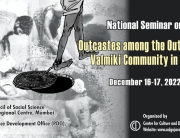
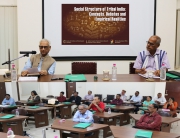
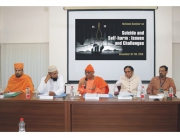
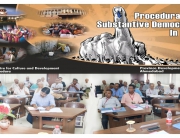
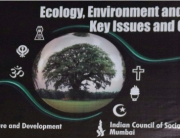
Add Comment